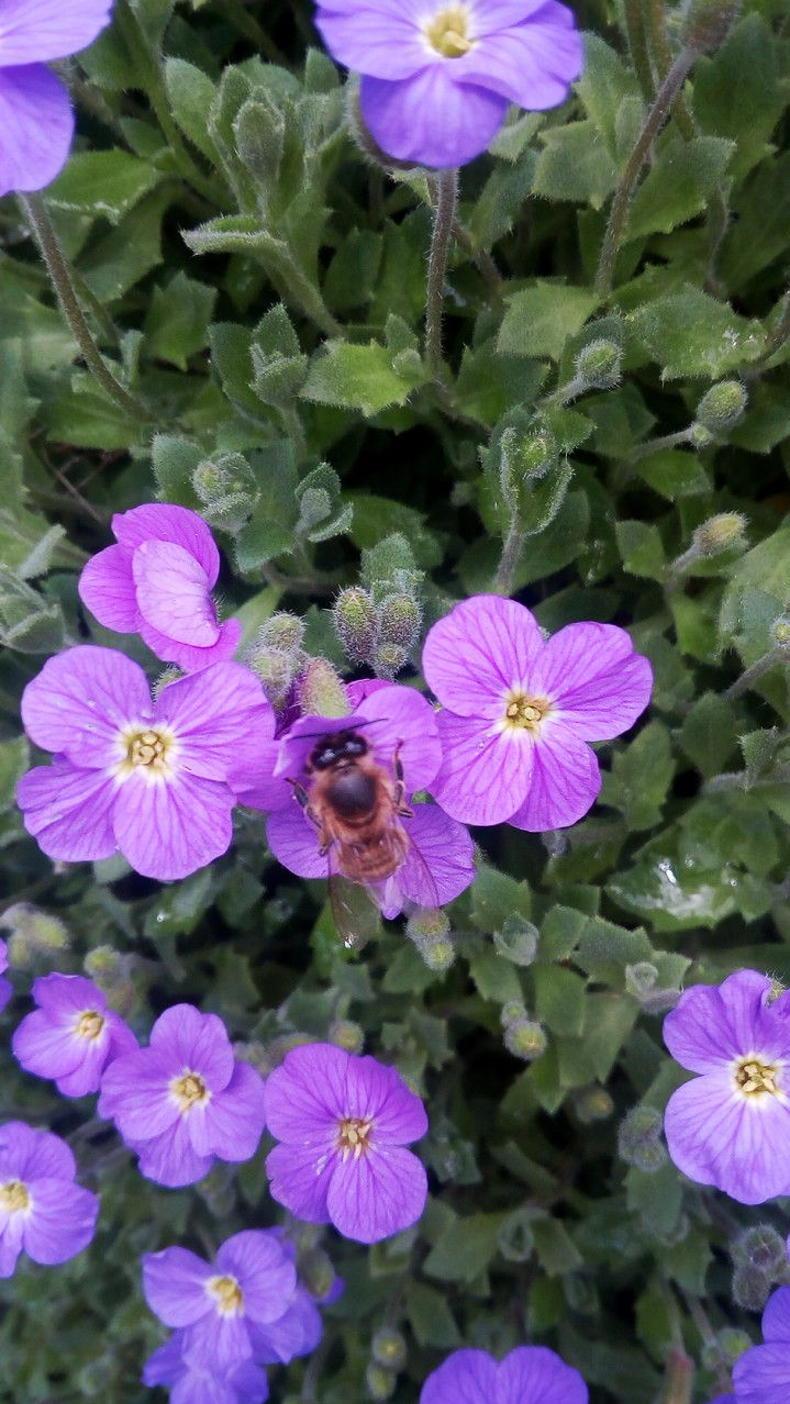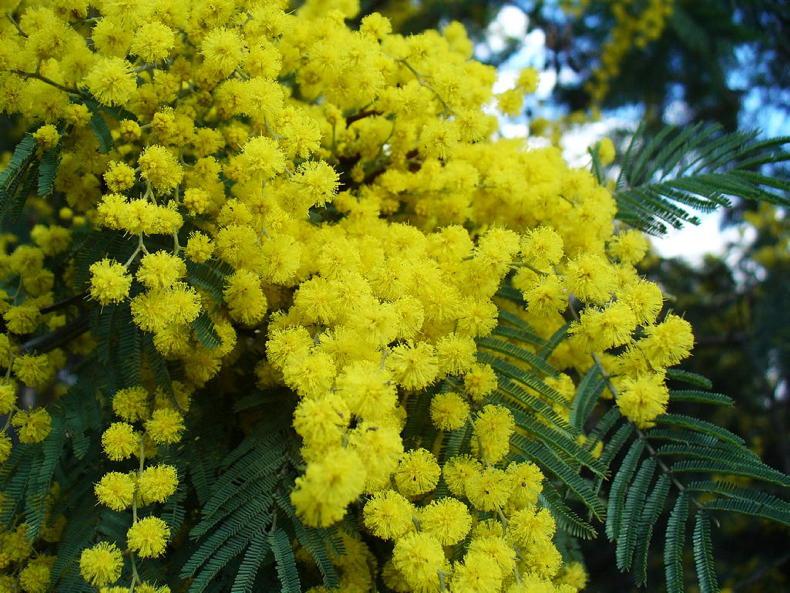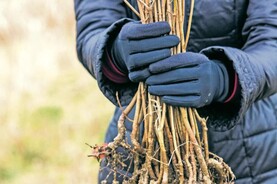Name
Acacias are known in their native land of Australia as ‘wattle’.
Presumably, the early settlers used the pliable branches of acacia to make wattle fences and walls of houses in the absence of the willow and hazel that would have been used in Europe. It is also known as florist’s mimosa.
It is common enough to see the magnificent flowers of mimosa close to the coast, but relatively rare inland.
A coastal strip of about 5km is the zone in which acacia reliably grows and flowers. This might seem like a very small zone but in fact, most of the population of the country is located in that narrow coastal strip.
Garden use
It is a different story for rural gardens as most will not be located in that strip but if you have a warm wall, south-facing, or a greenhouse, these beautiful trees can still be grown. They are very showy and worth the effort. They take pruning well and can be kept to a manageable size if pruned a little each year.
Even if they are pruned right back hard, they will flower again in the second or third year. Widely known as mimosa, Acacia dealbata, or the silver wattle, is the best known and most planted in this country. It has delicate ferny evergreen leaves which have a silvery back.
Botanical family
Mimosa is a member of the pea family and it likes free-draining soil. It also likes the soil to be reasonably fertile and it will grow 1m a year in good conditions. It needs good shelter and full sunshine to make rapid growth and it will also come into flower at a younger age when the growing conditions are good. If the shelter is not good, the lovely ferny foliage will be badly damaged and the flowering spoiled.
The other acacia commonly grown outdoors is the Cootamundra wattle, Acacia baileyana. This is a smaller-growing tree compared to the mimosa but there is good evidence that it is hardier than mimosas. It can be grown in a pot and taken into a greenhouse for protection.
It is spectacular sight from early January with masses of golden-yellow flowers draped over blue-green ferny foliage. There is a very pretty form that has purple-tinged young shoots called ‘Purpurea’ and this is probably more available than the ordinary green sort.
There are other acacias too, such as Acacia pravissima and Acacia armata. These are large shrubs, not as big as the other two, and therefore more suitable for greenhouse growing, or easier to accommodate on a warm wall.
They are about as hardy as the mimosa and usually need a very favoured position in an inland area, or greenhouse growing. Both are a bit more shapeless but can be pruned to a tidier shape.
Take out rockery weeds

Acacias.
Weeds can take hold in rockery plants during the winter and should be removed now before the growing season really picks up. Small plants such as aubrieta can be quickly swamped by weeds, such as annual meadow grass. If not removed, the weed will spread and slowly dominate the plant.
This is very important with young plants which have not yet become established. It is also important with older plants as these sometime open up a little and there is enough light for the weeds to grow. Strong established plants are generally able to cope with weed seedlings.
A good way of rejuvenating a tired clump of aubrieta is to mix up some sand and soil and place some of this over the bare patch. This causes the stems to produce new roots and shoot will soon follow. The layer of new growing material needs to be only a couple of centimetres deep or it will rot the stems.
Fruit, vegetables and herbs
Early varieties of cabbage, cauliflower, carrots, lettuce and onions can be started in a tunnel or glasshouse and planted out into better conditions during April or May when they have had a head-start. Take any opportunity that comes to carry out outdoor sowings. Plant garlic and shallot sets at the first chance.
Trees, shrubs and roses
A good watering at planting and two weeks later is usually all they need. Deciduous trees have begun to break bud in some cases and that spells the end of the bare-root planting season. Pot-grown plants can still be planted, of course.
Greenhouse and house plants
Sow tomato seeds for greenhouse growing now, you can also sow sweet peppers and chilli peppers. These are easy to grow and fill the greenhouse during the summer months. Delayed sowing will delay cropping. Pot up begonias and cannas for summer display in the greenhouse.
Flowers
Complete sowing of bedding flower seeds in the coming couple of weeks. If they are late sown, they will flower late and may be disappointing. Start them off in heat indoors and move them out to the cooler greenhouse. A small heated propagator is a great help. Lift and divide perennial flowers that have grown too large.
Lawns and meadows
With a lot of fresh interest being focused on wildflower lawns and wildflower meadows, take the time to assess whether either of these techniques suit your garden. Generally, they suit rural gardens very well, the lawn approach used in smaller areas, the meadow approach for large areas.
Read more
In the Garden with Gerry Daly: Daphne delights
In the Garden with Gerry Daly: winter-flowering cherry
Name
Acacias are known in their native land of Australia as ‘wattle’.
Presumably, the early settlers used the pliable branches of acacia to make wattle fences and walls of houses in the absence of the willow and hazel that would have been used in Europe. It is also known as florist’s mimosa.
It is common enough to see the magnificent flowers of mimosa close to the coast, but relatively rare inland.
A coastal strip of about 5km is the zone in which acacia reliably grows and flowers. This might seem like a very small zone but in fact, most of the population of the country is located in that narrow coastal strip.
Garden use
It is a different story for rural gardens as most will not be located in that strip but if you have a warm wall, south-facing, or a greenhouse, these beautiful trees can still be grown. They are very showy and worth the effort. They take pruning well and can be kept to a manageable size if pruned a little each year.
Even if they are pruned right back hard, they will flower again in the second or third year. Widely known as mimosa, Acacia dealbata, or the silver wattle, is the best known and most planted in this country. It has delicate ferny evergreen leaves which have a silvery back.
Botanical family
Mimosa is a member of the pea family and it likes free-draining soil. It also likes the soil to be reasonably fertile and it will grow 1m a year in good conditions. It needs good shelter and full sunshine to make rapid growth and it will also come into flower at a younger age when the growing conditions are good. If the shelter is not good, the lovely ferny foliage will be badly damaged and the flowering spoiled.
The other acacia commonly grown outdoors is the Cootamundra wattle, Acacia baileyana. This is a smaller-growing tree compared to the mimosa but there is good evidence that it is hardier than mimosas. It can be grown in a pot and taken into a greenhouse for protection.
It is spectacular sight from early January with masses of golden-yellow flowers draped over blue-green ferny foliage. There is a very pretty form that has purple-tinged young shoots called ‘Purpurea’ and this is probably more available than the ordinary green sort.
There are other acacias too, such as Acacia pravissima and Acacia armata. These are large shrubs, not as big as the other two, and therefore more suitable for greenhouse growing, or easier to accommodate on a warm wall.
They are about as hardy as the mimosa and usually need a very favoured position in an inland area, or greenhouse growing. Both are a bit more shapeless but can be pruned to a tidier shape.
Take out rockery weeds

Acacias.
Weeds can take hold in rockery plants during the winter and should be removed now before the growing season really picks up. Small plants such as aubrieta can be quickly swamped by weeds, such as annual meadow grass. If not removed, the weed will spread and slowly dominate the plant.
This is very important with young plants which have not yet become established. It is also important with older plants as these sometime open up a little and there is enough light for the weeds to grow. Strong established plants are generally able to cope with weed seedlings.
A good way of rejuvenating a tired clump of aubrieta is to mix up some sand and soil and place some of this over the bare patch. This causes the stems to produce new roots and shoot will soon follow. The layer of new growing material needs to be only a couple of centimetres deep or it will rot the stems.
Fruit, vegetables and herbs
Early varieties of cabbage, cauliflower, carrots, lettuce and onions can be started in a tunnel or glasshouse and planted out into better conditions during April or May when they have had a head-start. Take any opportunity that comes to carry out outdoor sowings. Plant garlic and shallot sets at the first chance.
Trees, shrubs and roses
A good watering at planting and two weeks later is usually all they need. Deciduous trees have begun to break bud in some cases and that spells the end of the bare-root planting season. Pot-grown plants can still be planted, of course.
Greenhouse and house plants
Sow tomato seeds for greenhouse growing now, you can also sow sweet peppers and chilli peppers. These are easy to grow and fill the greenhouse during the summer months. Delayed sowing will delay cropping. Pot up begonias and cannas for summer display in the greenhouse.
Flowers
Complete sowing of bedding flower seeds in the coming couple of weeks. If they are late sown, they will flower late and may be disappointing. Start them off in heat indoors and move them out to the cooler greenhouse. A small heated propagator is a great help. Lift and divide perennial flowers that have grown too large.
Lawns and meadows
With a lot of fresh interest being focused on wildflower lawns and wildflower meadows, take the time to assess whether either of these techniques suit your garden. Generally, they suit rural gardens very well, the lawn approach used in smaller areas, the meadow approach for large areas.
Read more
In the Garden with Gerry Daly: Daphne delights
In the Garden with Gerry Daly: winter-flowering cherry







 This is a subscriber-only article
This is a subscriber-only article









SHARING OPTIONS: